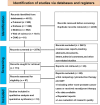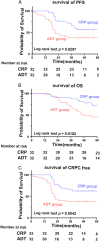Evaluating the effectiveness of cytoreductive surgery in oligometastatic prostate cancer: insights from quantitative analysis and retrospective cohort studies
- PMID: 39007913
- PMCID: PMC11745695
- DOI: 10.1097/JS9.0000000000001968
Evaluating the effectiveness of cytoreductive surgery in oligometastatic prostate cancer: insights from quantitative analysis and retrospective cohort studies
Abstract
Background: Oligometastatic prostate cancer (OmPCa) is characterized by a restricted number of metastatic lesions confined to a limited organ range, presenting a distinct clinical challenge. The role of cytoreductive prostatectomy (CRP) in managing this specific metastatic stage has gained attention but remains controversial. This study aims to assess the effectiveness of CRP in OmPCa by synthesizing outcomes from previous studies and analyzing data from a multicenter, retrospective cohort.
Methods: We focused on evaluating overall survival (OS), progression-free survival (PFS), cancer-specific survival (CSS), and castration-resistant prostate cancer-free survival (CRPCFS) as primary outcomes. A multicenter comparative retrospective analysis was also conducted on OmPCa patients treated with CRP versus those receiving androgen deprivation therapy (ADT) alone from January 2008 to June 2018. We gathered and analyzed data on patient demographics, tumor characteristics, surgical outcomes, and survival metrics.
Results: The quantitative analysis included 18 studies [2 randomized controlled trials (RCTs) and 16 non-RCT studies], comprising a total of 1733 patients with OmPCa, and this is the largest number of samples included in the same subject research at present. The pooled analysis demonstrated that cytoreductive surgery was associated with significantly improved OS [hazard ratio (HR) 0.50, 95% confidence interval (CI) 0.40-0.60], PFS (HR 0.39, 95% CI 0.27-0.51), CSS (HR 0.44, 95% CI 0.23-0.65), and CRPCFS (HR 0.48, 95% CI 0.36-0.59) compared to nonsurgical management. In addition, OS, PFS, and CRPCFS showed better results in the CRP group in all analyses (RCTs and non-RCTs). Additionally, in our multicenter retrospective research analysis, 64 patients with OmPCa were included, 32 underwent CRP (50%) and 32 underwent ADT alone (50%). The median follow-up time was 40.1 (18.9-51.3) months. The OS ( P =0.0182), PFS ( P =0.0297), and CRPCFS ( P =0.0125) had statistical differences between the two matched cohorts. Moreover, we observed 8 (25%) cases of perioperative complications, with the most common being urinary incontinence (9.4%).
Conclusions: Incorporating CRP alongside ADT in the treatment protocol for OmPCa significantly enhances patient outcomes in terms of OS, PFS, and CRPC-free survival, underscoring the potential benefit of this surgical approach in the specified patient population.
Copyright © 2024 The Author(s). Published by Wolters Kluwer Health, Inc.
Conflict of interest statement
The authors declares no conflicts of interest.
Sponsorships or competing interests that may be relevant to content are disclosed at the end of this article.
Figures






Similar articles
-
Cytoreductive prostatectomy may improve oncological outcomes in patients with oligometastatic prostate cancer: An updated systematic review and meta-analysis.Investig Clin Urol. 2023 May;64(3):242-254. doi: 10.4111/icu.20230058. Investig Clin Urol. 2023. PMID: 37341004 Free PMC article.
-
Outcomes of Cytoreductive Radical Prostatectomy for Oligometastatic Prostate Cancer on Prostate-specific Membrane Antigen Positron Emission Tomography: Results of a Multicenter European Study.Eur Urol Oncol. 2024 Aug;7(4):721-734. doi: 10.1016/j.euo.2023.09.006. Epub 2023 Oct 14. Eur Urol Oncol. 2024. PMID: 37845121
-
Local treatment benefits patients with oligometastatic prostate cancer: A systematic review and meta-analysis.Int J Urol. 2024 Nov;31(11):1223-1233. doi: 10.1111/iju.15540. Epub 2024 Jul 16. Int J Urol. 2024. PMID: 39011667
-
Prostatectomy and other local treatments for oligometastatic prostate cancer: recent and ongoing trials.Curr Opin Urol. 2025 Mar 1;35(2):171-177. doi: 10.1097/MOU.0000000000001251. Epub 2024 Nov 27. Curr Opin Urol. 2025. PMID: 39604252 Review.
-
Combination of Androgen Deprivation Therapy with Radical Local Therapy Versus Androgen Deprivation Therapy Alone for Newly Diagnosed Oligometastatic Prostate Cancer: A Phase II Randomized Controlled Trial.Eur Urol Oncol. 2022 Oct;5(5):519-525. doi: 10.1016/j.euo.2022.06.001. Epub 2022 Jun 29. Eur Urol Oncol. 2022. PMID: 35780048 Clinical Trial.
Cited by
-
Cytoreductive surgery for oligometastatic prostate cancer: a promising strategy - correspondence.Ann Med Surg (Lond). 2024 Sep 25;86(11):6898-6899. doi: 10.1097/MS9.0000000000002599. eCollection 2024 Nov. Ann Med Surg (Lond). 2024. PMID: 39525711 Free PMC article. No abstract available.
References
-
- Pinsky PF, Parnes H. Screening for prostate cancer. N Engl J Med 2023;388:1405–1414. - PubMed
-
- Deivasigamani S, Kotamarti S, Rastinehad AR, et al. . Primary whole-gland ablation for the treatment of clinically localized prostate cancer: a focal therapy society best practice statement. Eur Urol 2023;84:547–560. - PubMed
MeSH terms
LinkOut - more resources
Full Text Sources
Medical
Research Materials
Miscellaneous

